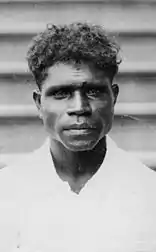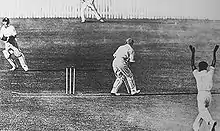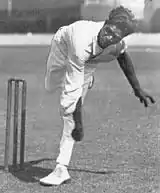Eddie Gilbert (cricketer)
Edward Gilbert (1 August 1905, Durundur Station, Queensland – 9 January 1978, Brisbane, Queensland) was a Queensland Aboriginal cricketer. He was an exceptionally fast bowler.
 | |||||||||||||||||||||||||||
| Personal information | |||||||||||||||||||||||||||
|---|---|---|---|---|---|---|---|---|---|---|---|---|---|---|---|---|---|---|---|---|---|---|---|---|---|---|---|
| Full name | Edward Gilbert | ||||||||||||||||||||||||||
| Born | 1 August 1905 Woodford, Queensland, Australia | ||||||||||||||||||||||||||
| Died | 9 January 1978 (aged 72) Wacol, Queensland, Australia | ||||||||||||||||||||||||||
| Batting | Left-handed | ||||||||||||||||||||||||||
| Bowling | Right arm fast | ||||||||||||||||||||||||||
| Domestic team information | |||||||||||||||||||||||||||
| Years | Team | ||||||||||||||||||||||||||
| 1930–1936 | Queensland | ||||||||||||||||||||||||||
| Career statistics | |||||||||||||||||||||||||||
| |||||||||||||||||||||||||||
Source: CricketArchive, 12 January 2010 | |||||||||||||||||||||||||||
Early years
Gilbert was taken from his home near Woodford at the age of three as part of a government policy on Aboriginal people and grew up on farms while living in the Barambah Aboriginal Reserve, now known as Cherbourg, north of Brisbane. He took up cricket at a young age, initially playing as a slow bowler but quickly developing pace cultivated through a flexible wrist that he said was from years of hard work and practice.
First class career
After playing with the State Colts in 1930, Gilbert was selected in the Queensland Sheffield Shield team in 1931. Gilbert was probably only the fifth Aboriginal Australian to play first-class cricket in Australia, after Twopenny in 1870, Johnny Mullagh in 1879, Jack Marsh in 1900, and Albert Henry in 1902. (Note that the 1868 Aboriginal cricket tour of England was not considered first-class.)
In his career, Gilbert played in 19 Sheffield Shield matches, taking 73 wickets at an average of 29.75. A further 14 wickets were taken off touring MCC, West Indies and South African sides. In one match against the touring West Indian team, he took 5/65. Despite his success, it is unlikely that he was ever seriously considered for the Australian Test team due to doubts about his action, his Aboriginality and the fact that he represented Queensland, then a relatively weak team.
The era of 'protection'
As an Aboriginal man living in Queensland in 1931, Eddie Gilbert was bound by the restrictions of the Protection of Aboriginals Act 1897. This meant that he needed written permission to travel from his Aboriginal settlement each time he played in a first-class match. Reference to his correspondence survives in the Queensland State Archives. (QSA A/4736, Home Secretary, Register of Letters Received, 1931, Extracts - Aborigines General).
Dismissing Bradman

On 6 November 1931 in a match against NSW at the recently opened Brisbane Cricket Ground (the "Gabba") in Brisbane, he dismissed opener Wendell Bill for a duck with his first ball. The incoming batsman was Don Bradman.
Bradman was hurried by Gilbert, but he somehow managed to keep the first ball out. The second was a harmless one, just outside leg. The third ball was too quick: it screamed past Bradman's bat and thudded into the gloves of Leonard Waterman. The fourth was as fast, and hit Bradman on his underbelly. The impact knocked his bat off, leaving him in agony. It took him time, but he got back to his feet. Then came the bouncer, a really quick one. Bradman tried to counterattack, but it was too quick. The top-edge went up in the air, and Waterman took it easily.[1]
Bradman recalled years later that the five deliveries he faced from Gilbert in that match were the fastest he had experienced in his career. Bradman said The keeper took the ball over his head, and I reckon it was halfway to the boundary and that the balls from Gilbert were unhesitatingly faster than anything seen from Larwood or anyone else. Although as he added in his autobiography, Bradman thought Gilbert's action was 'decidedly suspect'.
Gilbert played against Bradman on two more occasions, as well as Douglas Jardine during the infamous 1932/33 Bodyline tour.
Bowling action

Though he had a controversial action he was called only once for throwing and that for jerking his wrist. Importantly the straightness of his arm was never contradicted by umpires. The occasion of him being called was the match between Victoria and Queensland at the MCG in 1931. The umpire Andrew Barlow, no-balled him 13 times for his action.
Alan McGilvray said he had "absolutely no doubt" that Gilbert was "the fastest bowler I ever saw" and that "no matter how I analyse cricket down the years, I cannot imagine anybody bowling a ball faster than Eddie Gilbert". Of the legality of Gilbert's action, McGilvray commented, "It was hard to tell whether he actually chucked or not, because he let the ball go with such a fling of his right arm you got precious little sight of it."[2]
Retirement
Gilbert retired from the game in 1936 due to poor form whereupon officials in the Queensland Cricket Board and the Aboriginal Protectorate arranged for his return to an Aboriginal settlement. Gilbert died at the Wolston Park Hospital near Brisbane on 9 January 1978, aged 72 after many years of ill health due to alcoholism and mental illness, when the truth was his mental condition was because he was labelled a cheat and didn't recover and on top of that he wasn't allowed to sleep with the team and was put in a tent on the practice pitch. In 2015 Gilbert's son Barney unveiled the sign at the dedication of the Eddie Gilbert Memorial Field near the hospital, with folk singer Dermot Dorgan offering his tribute song "Eddie Gilbert" about the life and struggles of the iconic fast bowler.[3]
Recognition
In 2007 Queensland Cricket erected a bronze statue of Gilbert in Greg Chappell Street, outside Allan Border Field, Albion.[4] Designed by Pauline Clayton, the statue shows Gilbert in full flight. The monument was dedicated in November 2008.[5] In 2007, Indigenous Sport Queensland established the Eddie Gilbert Medal to recognise Queensland’s best indigenous sports person.[6]
See also
- List of cricketers called for throwing in top-class cricket matches in Australia
- 1868 Aboriginal cricket tour of England
- Twopenny - Aboriginal Australian who played for New South Wales against Victoria in 1870
- Johnny Mullagh - Aboriginal Australian who played for Victoria against the MCC in 1879
- Albert Henry - Aboriginal Australian who played for Queensland from 1902 to 1905
Notes
- http://www.cricketcountry.com/articles/don-bradman-and-his-ducks-179098
- Alan McGilvray, The Game Goes On, ABC Books, Sydney, 1987, pp. 111-12.
- Gould, J. (9 July 2015) A field of dreams for Aboriginal bowler who bounced Bradman Queensland Times
- English, Peter (2014). "The long tail". ESPN Crickinfo. Archived from the original on 12 November 2014. Retrieved 1 August 2015.
- http://monumentaustralia.org.au/themes/people/indigenous/display/90365-eddie-gilbert/photo/5
- "Sports awards". Indigenous Sport Queensland website. Retrieved 30 November 2015.
References
- Eddie Gilbert - The True Story Of An Aboriginal Cricketing Legend by Mike Colman and Ken Edwards. ABC Books (2002).
- Australian Dictionary of Biography entry, http://www.adb.online.anu.edu.au/biogs/A090003b.htm
- Indigenous first-class and Test cricketers, 1860s to 1960s, australia.gov.au